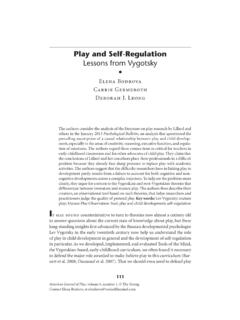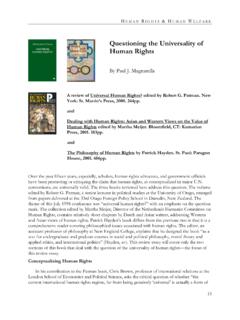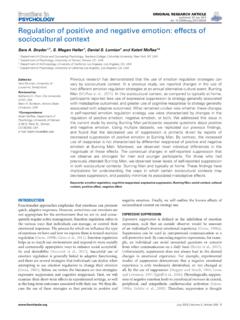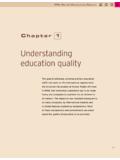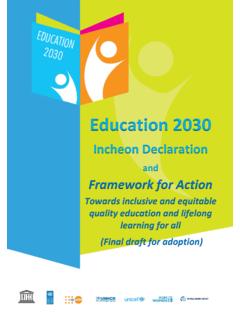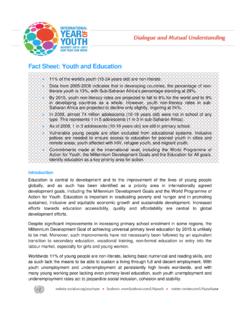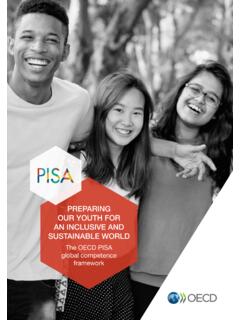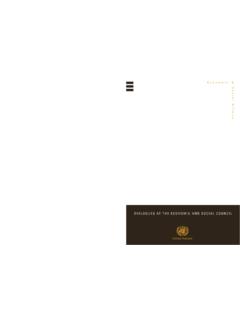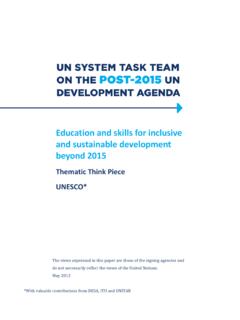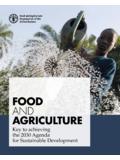Transcription of Inclusive Education and Children with Disabilities in Ethiopia
1 Inclusive Education and Children with Disabilities in Ethiopia Brittany Franck First-Place Award, JKSIS Student Contest, 2015 Education and Development University of Denver 2013 (revised 2015) Abstract Educational provision for students with Disabilities is essential if Ethiopia is to reach Education for All goals; however, despite a series of strategies and new legislation aiming to support inclusion of people with Disabilities , a majority of Children with Disabilities are still out of school. This paper seeks to understand why achieving Inclusive Education has remained elusive. It begins with an overview of global and national definitions of Inclusive Education .
2 The reality of schooling options currently available to students with Disabilities are then discussed, followed by an exploration of how stigma, inadequate training and institutional barriers have rendered these provisions inadequate and inequitable. Three case studies of Inclusive Education programs in Ethiopia , Zambia and Uganda are then presented and recommendations made based on their successes. The paper concludes by arguing that inclusion will not be achieved by merely focusing on access, but must involve changes in society and systems and a critical reflection on the objectives of Inclusive Education for students with Disabilities . (Key words: Inclusive Education , Disabilities , Ethiopia ) Franck 2 Ethiopia has an estimated 691,765 disabled Children ; of these, only about 2,300 are enrolled in school (Lewis, 2009) 1, with a high risk of dropping out (MoE and UNESCO, 2012).
3 These numbers are concerning in the context of a country which has committed itself to international proclamations advocating for the rights of Children with Disabilities to educational access, included ideals of supporting people with Disabilities in its constitution, and developed national plans for special needs Education (International Labor Organization, 2013)2. However, when one looks beyond these policies and declarations and views the realities of primary school classrooms and their surrounding communities, it becomes clear that achieving Education for All, most specifically Children with Disabilities , involves much more than establishing policies and placing students in classrooms.
4 Achieving true inclusion in Ethiopia will require action that is rooted in the conviction that Inclusive Education is not merely about access, but about changes in society and systems. Development of Concepts: Inclusion and Disability There are a myriad of definitions for Inclusive Education , integrated Education and special needs Education , leading to different interpretations in policy language and implementation (Lewis, 2009). According to a UNESCO-commissioned report on Education for All, Ethiopia utilizes the terms special needs Education and Inclusive Education as one concept, defined as focus[ing] on Children and students who are at risk of repetition and dropout due to learning difficulties, Disabilities , socio-emotional problems, or are excluded from Education (ibid: 22).
5 Importantly, this statement recognizes Children with Disabilities as a group at risk of drop out, echoed in Ethiopia s Study on Situation of Out of School Children (2012); however, further clarification is needed to understand the core of the term inclusion. In the same UNESCO 1 See Appendix 1 2 See Appendix 2 Franck 3 Report, inclusion was defined as bringing about change in the Education system by identifying and solving barriers to presence, participation, and achievement for every learner within mainstream settings (ibid: 5). This statement mentions the crucial difference between Inclusive Education and integrated Education , with the former demanding changes in the Education system and the latter demanding changes within the learner (Lewis, 2009; Kangwa and Bonati, 2003; Chhabra, Srivastava and Srivastava, 2010).
6 In this context, simply placing a student in a mainstream classroom, without the necessary adjustments in the Education system does not qualify as Inclusive Education ; rather, it is merely integrating. Inclusion is thus a process , not merely about access but also about Education quality and completion (Miles and Singal, 2010: 10, 14). The definition of disability is likewise varied and deals with the concept of external barriers. The World Health Organization s (2013) definition of disability involves the interplay between impairments, activity limitations, and participation restrictions whereby disability is the interaction between the impairment that a person has and the limitations imposed by their physical or social environment (WHO, 2013).
7 Thus, it is through interactions with society that one s disability becomes a limitation. In this way, society itself can become disabling (UNESCO, 1994). This idea of impairments interacting with external limitations is echoed in the Convention on the Rights of Persons with Disabilities and Handicap International (United Nations, 2006; Handicap International, 2013). This definition illuminates the idea that when people with Disabilities are excluded from Education , it is this exclusion that limits them, not the impairment itself (Peters, 2009: 149). The Current State of Education for Disabled Children in Ethiopia : the Case of Vision-Impaired Students in Northern Ethiopia Franck 4 The Ministry of Education has asserted that Ethiopia can not [sic] attain MDG ignoring the marginalized and those with learning difficulties and impairments (Lewis, 2009: 23).
8 The connection between poverty and disability is widely acknowledged (Singal, 2009), with disability being both a cause and a result of poverty (Handicap International, 2013). Thus, this issue is critical not only to individuals but also to Ethiopia s development. It is therefore urgent that changes are made in the Education system and society that allow for equal participation of people with Disabilities in Education so they will have the opportunity to contribute to Ethiopia s progress. The Education system in which these changes need to be made has challenges in its structure and founding principles. Educational provision for students with Disabilities offers the following primary school options: fifteen special schools, 285 special units attached to mainstream schools, and an unknown number of schools offering integration into mainstream classes (MoE and UNESCO, 2012).
9 Special schools in many developing countries are characterized by low quality and lack of regulation (Miles and Singal, 2010). The special schools in Ethiopia are not exception to this, and are often crowded, poorly staffed, under-resourced, and generally concentrated in urban areas (Lewis, 2009). The following example3 from northern Ethiopia is provided to give a brief glimpse into the special and mainstream school settings that disabled students experience. This description begins with a boarding school for vision-impaired students, which, like many special schools, was founded by a charity organization but is now government-run. The school s poor sanitation, overcrowded housing and inadequate childcare staff reflect the immense challenges, and the ethical dilemma, of maintaining segregated schools for disabled students in an already resource-scarce context.
10 The students are not offered 3 Information based on personal observation as a Peace Corps Education volunteer in Mekelle, Ethiopia . 2011-2013. Franck 5 vocational or life skills training and are thus ill-prepared for life in the community; therefore, the students often must resort to begging after exiting the boarding school, despite having completed their primary school Education . The Children rarely see their families during their eight-year stay at the school and are excluded from community life. Until very recently, however, this school was one of very few options for disabled Children , and every year, there are more requests for enrollment than the school can accept.



